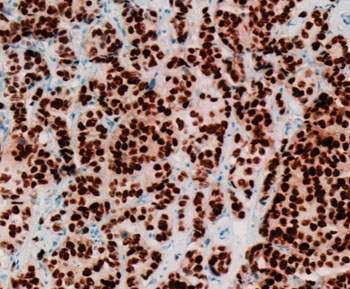Second Pathology Analysis Ensures Proper Diagnosis and Treatment
By LabMedica International staff writers
Posted on 28 May 2015
A pathologic diagnosis is the foundation upon which all other treatment decisions are made with breast cancer and with the emergence of target therapy, the pathology dictates the use of potentially curable therapy.Posted on 28 May 2015
Patients with breast disease receive appropriate care based on accurate diagnoses and accurate identification of predictive and prognostic markers as an incorrect pathologic diagnosis may lead to negative outcomes as serious as failure to treat a missed case of breast cancer or provision of unnecessary surgery, chemotherapy, and radiation.

Image: Immunohistochemistry of stained estrogen receptor-positive breast cancer surgical pathology specimen (Photo courtesy of Dr. Ronald S. Weinstein, MD).
Pathologists at the Roswell Park Cancer Institute (Buffalo, NY, USA) reviewed 502 breast core biopsy cases provided by referring institutions in a single calendar year. A core needle biopsy is a procedure that removes small samples of breast tissue which are then analyzed for characteristics of breast disease. The cases in the study were defined as reflecting a minor discordance when the change in diagnosis did not impact the patient and a major discordance when patient care was impacted through a change in therapy modality.
The team found that 8% of the cases had a major discordance and 13% had a minor discordance. The most common reason for major discordance is interpreting biomarkers such the estrogen receptor (ER), progesterone receptor (PR) and human epidermal growth factors type 2 (HER-2). These biomarkers can determine treatment options and may predict breast cancer survival. The second most common reason was borderline diseases. The change of diagnosis from benign to malignant or vice versa, while less common, was identified in 1% of the cases examined. This change has the most significant impact on patient care and outcome.
The scientists did not find any difference in the rate of discordance between institutions or with regard to the pathologists' seniority. However, none of the providing pathologist was specialized in breast pathology which might explain the discordance. In conclusion, they recommend that second review of the original pathologic material should be evaluated by specialized pathologist prior to any therapeutic implementations. Thaer Khoury, MD, a coauthor of the study said, “Surgical pathology is a dynamically changing specialty with frequently updated guidelines and classifications. This study underscores the need for a second review of the original pathologic material by a pathologist who specializes in breast cancer prior to implementation of breast cancer therapy.” The study was published online on April 15, 2015, in the Breast Journal.
Related Links:
Roswell Park Cancer Institute














